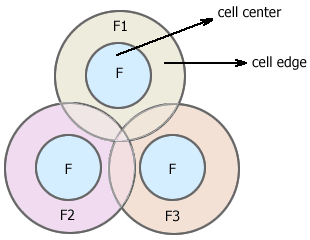Fractional Frequency Reuse in Mobile WiMAX
Frequency spectrum is a limited and increasingly expensive
resource. Wireless network operators or WISPs often have to compete in
acquiring
licenses to operate on frequencies of their choice. Of course, they
still have another
alternative, that's using free spectrum in license-exempt bands. But then,
they have to find the means to control interference from other networks
sharing the same band and to limit spillover to other users
of the band.
Mobile WiMAX in mobile mode (remember, Mobile WiMAX also
supports fixed mode) will be deployed like a cellular
network (2G, 3G), requiring a large number of base stations to
have a considerable coverage. So in most cases it will operate in
licensed bands. Operation in unlicensed bands may be considered
only for greenfield deployment where there are no other users of the same
spectrum.

Picture. Fractional Frequency Reuse
F1, F2, and F3 are different sets of sub-channels, allocated to
users at cell edges.
F = F1+F2+F3. The whole sub-channels (F) are allocated to users at cell centers.
Regardless of licensed or unlicensed spectrum, frequencies have
to be used efficiently. Therefore, it's crucial to maintain
frequency reuse one. Frequency reuse one is achieved when all
sectors within a cell and all cells within a network operate
on the same frequency channel. However,
frequency reuse one in a cellular network implies that
users at a cell edge may get degraded signals due to interference
from adjacent cells.
Mobile WiMAX addresses this issue by "tweaking" the frequency
reuse one. It works by allowing users at a cell center to operate
on all available sub-channels. Cell center is the area closer to a
base station (BS) that is particularly immune to co-channel interference. While users at a cell edge are only allowed to
operate on a fraction of all available sub-channels. This
sub-channels fraction is allocated in such a way that adjacent cells' edges will
operate on different
sets of sub-channels (see picture above). This is called
fractional frequency reuse.
Fractional frequency reuse takes advantage of the fact that a
Mobile WiMAX user transmits on sub-channels (because in OFDMA, a channel is divided into
sub-channels) and doesn't occupy an entire
channel such as in 3G (CDMA2000 or WCDMA). Fractional frequency reuse
maximizes spectral efficiency for users at a cell center and
improves signal strength and throughput for users at a cell edge.
|